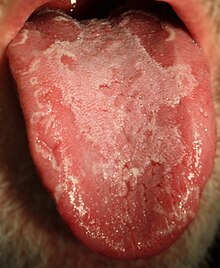| Geographic tongue | |
|---|---|
 | |
| A patient with geographic tongue | |
| Specialty | Oral Medicine, Oral and Maxillofacial Surgery, Dermatology |
| Symptoms | Burning sensation (rare) |
| Causes | Unknown |
| Diagnostic method | Visual examination |
| Differential diagnosis | Oral lichen planus, erythematous candidiasis, leukoplakia, glossitis, and chemical burns |
| Prevention | None |
| Treatment | Reassurance, time |
| Medication | None |
| Frequency | 2-3% |
| Deaths | None |
Geographic tongue, also known by several other terms,[note 1] is a condition of the mucous membrane of the tongue, usually on the dorsal surface. It is a common condition, affecting approximately 2–3% of the general population.[2][7] It is characterized by areas of smooth, red depapillation (loss of lingual papillae) which migrate over time. The name comes from the map-like appearance of the tongue,[8] with the patches resembling the islands of an archipelago.[2] The cause is unknown, but the condition is entirely benign (importantly, it does not represent oral cancer), and there is no curative treatment. Uncommonly, geographic tongue may cause a burning sensation on the tongue, for which various treatments have been described with little formal evidence of efficacy.
- ^ a b Cite error: The named reference
Kerawala 2010was invoked but never defined (see the help page). - ^ a b c Mangione, Salvatore (2012). Physical Diagnosis Secrets: With STUDENT CONSULT Online Access. Elsevier. pp. 604–605. ISBN 978-0323112116. Retrieved November 12, 2012.
- ^ "Geographic Glossitis entry on Medical Subject Headings (MeSH)". National Library of Medicine. Retrieved 19 July 2013.
- ^ Cite error: The named reference
Neville 2001was invoked but never defined (see the help page). - ^ James, William D.; Berger, Timothy G.; et al. (2006). Andrews' Diseases of the Skin: Clinical Dermatology. Saunders Elsevier. p. 800. ISBN 978-0-7216-2921-6.
- ^ Rapini, Ronald P.; Bolognia, Jean L.; Jorizzo, Joseph L. (2007). Dermatology: 2-Volume Set. St. Louis: Mosby. ISBN 978-1-4160-2999-1.
- ^ Ship, Jonathan A.; Joan Phelan, and A. Ross Kerr (2003). "Chapter 112: Biology and Pathology of the Oral Mucosa". In Freedberg; et al. (eds.). Fitzpatrick's Dermatology in General Medicine (6th ed.). McGraw-Hill. p. 1208. ISBN 0-07-138067-1.
- ^ Desai, A. B.; Vishwanathan, J. (1989). Textbook Of Paediatrics. India: Orient Blackswan. p. 405. ISBN 978-8125004400. Retrieved November 12, 2012.
Cite error: There are <ref group=note> tags on this page, but the references will not show without a {{reflist|group=note}} template (see the help page).